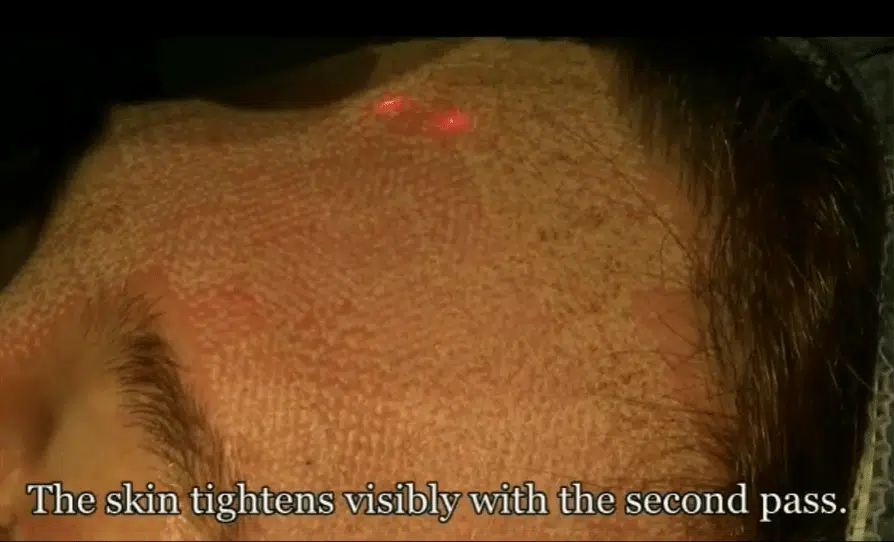
Home / Procedures / Laser Skin Resurfacing
Rejuvenate your skin and erase imperfections with our expert providers’ Laser Skin Resurfacing in Cincinnati, OH. Reveal a smoother, younger-looking you with this advanced non-invasive procedure.

Wrinkle Reduction
Laser treatments stimulate collagen production, reducing the appearance of wrinkles and fine lines.
Scar Improvement
Laser resurfacing can minimize the appearance of scars, leaving behind smoother skin.
Sun Damage Reversal
Reveal brighter skin by addressing sunspots and pigmentation issues with laser skin resurfacing.
Laser skin resurfacing is a cosmetic surgery procedure that resurfaces the facial skin to improve the appearance of wrinkles, crow’s feet, acne scarring, and sun damage. Laser skin resurfacing utilizes a carbon dioxide (CO2) laser device that instantly vaporizes the top layer of skin, resulting in a more youthful and rejuvenated appearance. Our expert providers use the Lumenis Ultrapulse fractionated CO2 laser, which is the gold standard for laser resurfacing. Because it is a fractionated laser, it treats a selected fraction of the skin surface rather than the entire surface, helping preserve skin cells to aid in healing and the return of natural pigment. The result is a safer procedure with less downtime than traditional CO2 lasers.
During your initial consultation, our expert providers will consider factors such as skin texture, type and color, ethnicity, age, and medical history to determine if the procedure is right for you.
They will address any skin concerns you may have and go over procedural details, including the technique, number of treatment sessions, anesthesia, risks, and costs.
Individuals who are looking to improve the appearance of facial wrinkles, sun damage, uneven pigmentation, and/or acne scars may be good candidates for laser skin resurfacing. As with all forms of cosmetic surgery, good health and realistic expectations are essential. Patients must understand that the goal of the treatment is to improve healthy skin as much as possible rather than produce perfect skin.
Laser Skin Resurfacing Before & Afters
*Each patient is unique and individual results may vary.
Laser skin resurfacing is performed on an outpatient basis and requires no hospitalization or general anesthesia compared to surgical procedures.
Local anesthesia and sedation may be used for the procedure. During treatment, the laser device is passed over the damaged skin, allowing the high laser energy, amplified light waves to vaporize the top layer of skin. The laser resurfacing technology also stimulates collagen production under the surface of the skin, resulting in improvement in tone, texture, color, and younger-looking skin.
Depending on the number and size of areas being treated, the procedure may take anywhere from a few minutes to an hour to complete. More than one session may be required.
Why Choose Donath Facial Plastic Surgery?
The potential risks associated with laser skin resurfacing include infections, permanent changes in pigmentation, and the formation of cold sores. Our expert providers take every precaution to minimize these risks by providing a personalized treatment plan that considers your individual goals, medical history, and skin type. Our precise treatment settings allow us to administer controlled energy levels for safety and efficacy.

After treatment, patients can expect minimal discomfort, some redness, swelling, and crusting of the treated skin. The new skin will emerge within one to two weeks during the recovery time after treatment. As part of the natural healing process, it will appear pink and free of many wrinkles.
Redness will fade within about three to four weeks. It may be necessary to follow a soft diet for some time, and the treated skin will need to be protected against extremes in temperature and sun exposure. To help accelerate the healing process and reduce swelling, patients may use ice packs throughout their recovery period. Sun protection is also important as the treated skin will be extremely sensitive to UV rays. Sunblock with SPF 30 or higher should always be worn when outdoors; sunglasses and hats can also provide extra protection.
Most patients find that they can return to work and most other normal activities within about two weeks after undergoing laser skin resurfacing.
The facial laser resurfacing procedure I had done resulted in an amazingly fresh face. I honestly believe it took years off my skin. I was apprehensive about the procedure, but the results were much better than I expected. What I really noticed was the tightening of my upper lids, as well as an overall firming effect. The team at Donath Facial Plastic Surgery was wonderful. Thank you!
Laser skin resurfacing is a cosmetic procedure that uses a carbon dioxide (CO2) laser device to instantly vaporize the top layer of skin. It can reduce the visibility of wrinkles, crow’s feet, acne scarring, and sun damage, resulting in smoother skin.
The experienced team at our expert providers’ clinic will assess your skin, discuss your desired outcomes, and gather your medical history during your laser skin resurfacing consultation. They will consider factors such as your skin type and color, age, and ethnicity when determining suitability for the procedure. Any questions or concerns can be addressed, and detailed information about the treatment plan, anesthetic options, risks, and costs will be provided.
Laser skin treatment may be performed with local anesthesia and sedation.
Once the anesthesia is administered, a laser device is passed over the skin. The high-energy, amplified light waves are absorbed into the skin and vaporize the top layer. Patients require more than one session to achieve optimum results.
Laser skin resurfacing may take anywhere from a few minutes to an hour to perform, depending on the area being treated.
Some minor discomfort may occur after the laser resurfacing treatment, though this can be managed with prescription pain medication if necessary.
Any discomfort that patients experience after laser skin resurfacing is usually minor and can be controlled with medication. Some redness, swelling, and crusting of the skin can be expected after treatment, and it may take three to four weeks for the redness to fade fully. Within one to two weeks, you will notice an improvement in skin texture. Patients may need to follow a soft diet for some time after treatment. Sun exposure and extremes in temperature will need to be avoided.
Work and most other normal activities can usually be resumed within about two weeks after the procedure.
Are you sure we can’t help?
"*" indicates required fields